





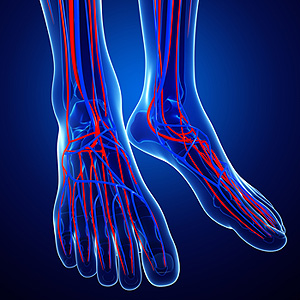 Poor circulation refers to inadequate blood flow to a part of the body. Poor circulation to the legs and feet is particularly concerning as it can lead to serious medical complications, in severe cases this could include amputation. The most common symptoms of poor circulation are numbness and tingling in the feet, cold feet, swelling in the feet, ankles, or legs, skin color changes, and foot ulcers. Poor circulation is typically caused by plaque buildup in the blood vessels. The plaque hardens and narrows the blood vessels, restricting blood flow to the affected areas. When those affected areas are the lower limbs, this is known as peripheral artery disease or PAD. A podiatrist can screen for this condition during a routine visit. If you experience poor circulation to the lower limbs, it is suggested that you consult with a podiatrist today.
Poor circulation refers to inadequate blood flow to a part of the body. Poor circulation to the legs and feet is particularly concerning as it can lead to serious medical complications, in severe cases this could include amputation. The most common symptoms of poor circulation are numbness and tingling in the feet, cold feet, swelling in the feet, ankles, or legs, skin color changes, and foot ulcers. Poor circulation is typically caused by plaque buildup in the blood vessels. The plaque hardens and narrows the blood vessels, restricting blood flow to the affected areas. When those affected areas are the lower limbs, this is known as peripheral artery disease or PAD. A podiatrist can screen for this condition during a routine visit. If you experience poor circulation to the lower limbs, it is suggested that you consult with a podiatrist today.
Poor circulation is a serious condition and needs immediate medical attention. If you have any concerns with poor circulation in your feet contact one of our podiatrists of Active Foot and Ankle Care, LLC. Our doctors will treat your foot and ankle needs.
Poor Circulation in the Feet
Poor blood circulation in the feet and legs is can be caused by peripheral artery disease (PAD), which is the result of a buildup of plaque in the arteries.
Plaque buildup or atherosclerosis results from excess calcium and cholesterol in the bloodstream. This can restrict the amount of blood which can flow through the arteries. Poor blood circulation in the feet and legs are sometimes caused by inflammation in the blood vessels, known as vasculitis.
Causes
Lack of oxygen and oxygen from poor blood circulation restricts muscle growth and development. It can also cause:
Those who have diabetes or smoke are at greatest risk for poor circulation, as are those who are over 50. If you have poor circulation in the feet and legs it may be caused by PAD and is important to make changes to your lifestyle in order to reduce risk of getting a heart attack or stroke. Exercise and maintaining a healthy lifestyle will dramatically improve conditions.
As always, see a podiatrist as he or she will assist in finding a regimen that suits you. A podiatrist can also prescribe you any needed medication.
If you have any questions please feel free to contact our offices located in Fair Lawn, Riverdale, and Englewood, NJ . We offer the newest diagnostic and treatment technologies for all your foot and ankle needs.
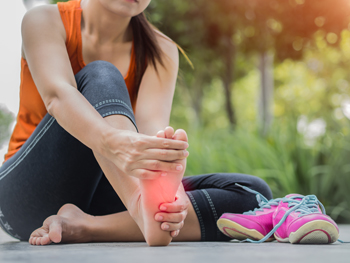 Cycling is becoming increasingly popular as a form of exercise. However, as a cyclist, you must be wary of injuries to your ankle or foot. Luckily, there are preventative measures that you can take to save yourself from the pain of an injury. One of the most common ankle injuries from cycling is Achilles tendonitis, an overuse injury of the tendon that runs from the calf muscle to the back of the foot. Training too much, or too hard too quickly, can increase your risk of Achilles tendonitis. To help prevent this injury, try to break up your cycling to allow adequate time for rest and healing. Another common problem among cyclists is foot numbness. This may be caused by ill-fitting shoes or a lot of uphill riding. To help prevent foot numbness, make sure that you are wearing properly-fitted shoes, and add more variety to your rides so that you are not always cycling uphill. For more information on how to prevent and treat cycling injuries of the feet and ankles, talk to a podiatrist today.
Cycling is becoming increasingly popular as a form of exercise. However, as a cyclist, you must be wary of injuries to your ankle or foot. Luckily, there are preventative measures that you can take to save yourself from the pain of an injury. One of the most common ankle injuries from cycling is Achilles tendonitis, an overuse injury of the tendon that runs from the calf muscle to the back of the foot. Training too much, or too hard too quickly, can increase your risk of Achilles tendonitis. To help prevent this injury, try to break up your cycling to allow adequate time for rest and healing. Another common problem among cyclists is foot numbness. This may be caused by ill-fitting shoes or a lot of uphill riding. To help prevent foot numbness, make sure that you are wearing properly-fitted shoes, and add more variety to your rides so that you are not always cycling uphill. For more information on how to prevent and treat cycling injuries of the feet and ankles, talk to a podiatrist today.
Sports related foot and ankle injuries require proper treatment before players can go back to their regular routines. For more information, contact one of our podiatrists of Active Foot and Ankle Care, LLC. Our doctors can provide the care you need to keep you pain-free and on your feet.
Sports Related Foot and Ankle Injuries
Foot and ankle injuries are a common occurrence when it comes to athletes of any sport. While many athletes dismiss the initial aches and pains, the truth is that ignoring potential foot and ankle injuries can lead to serious problems. As athletes continue to place pressure and strain the area further, a mild injury can turn into something as serious as a rupture and may lead to a permanent disability. There are many factors that contribute to sports related foot and ankle injuries, which include failure to warm up properly, not providing support or wearing bad footwear. Common injuries and conditions athletes face, including:
Sports related injuries are commonly treated using the RICE method. This includes rest, applying ice to the injured area, compression and elevating the ankle. More serious sprains and injuries may require surgery, which could include arthroscopic and reconstructive surgery. Rehabilitation and therapy may also be required in order to get any recovering athlete to become fully functional again. Any unusual aches and pains an athlete sustains must be evaluated by a licensed, reputable medical professional.
If you have any questions please feel free to contact our offices located in Fair Lawn and Riverdale, New Jersey. We offer the newest diagnostic and treatment technologies for all your foot and ankle needs.
Read more about Sports Related Foot and Ankle Injuries Cycling is becoming increasingly popular as a form of exercise. However, as a cyclist, you must be wary of injuries to your ankle or foot. Luckily, there are preventative measures that you can take to save yourself from the pain of an injury. One of the most common ankle injuries from cycling is Achilles tendonitis, an overuse injury of the tendon that runs from the calf muscle to the back of the foot. Training too much, or too hard too quickly, can increase your risk of Achilles tendonitis. To help prevent this injury, try to break up your cycling to allow adequate time for rest and healing. Another common problem among cyclists is foot numbness. This may be caused by ill-fitting shoes or a lot of uphill riding. To help prevent foot numbness, make sure that you are wearing properly-fitted shoes, and add more variety to your rides so that you are not always cycling uphill. For more information on how to prevent and treat cycling injuries of the feet and ankles, talk to a podiatrist today.
Cycling is becoming increasingly popular as a form of exercise. However, as a cyclist, you must be wary of injuries to your ankle or foot. Luckily, there are preventative measures that you can take to save yourself from the pain of an injury. One of the most common ankle injuries from cycling is Achilles tendonitis, an overuse injury of the tendon that runs from the calf muscle to the back of the foot. Training too much, or too hard too quickly, can increase your risk of Achilles tendonitis. To help prevent this injury, try to break up your cycling to allow adequate time for rest and healing. Another common problem among cyclists is foot numbness. This may be caused by ill-fitting shoes or a lot of uphill riding. To help prevent foot numbness, make sure that you are wearing properly-fitted shoes, and add more variety to your rides so that you are not always cycling uphill. For more information on how to prevent and treat cycling injuries of the feet and ankles, talk to a podiatrist today.
Sports related foot and ankle injuries require proper treatment before players can go back to their regular routines. For more information, contact one of our podiatrists of Active Foot and Ankle Care, LLC. Our doctors can provide the care you need to keep you pain-free and on your feet.
Sports Related Foot and Ankle Injuries
Foot and ankle injuries are a common occurrence when it comes to athletes of any sport. While many athletes dismiss the initial aches and pains, the truth is that ignoring potential foot and ankle injuries can lead to serious problems. As athletes continue to place pressure and strain the area further, a mild injury can turn into something as serious as a rupture and may lead to a permanent disability. There are many factors that contribute to sports related foot and ankle injuries, which include failure to warm up properly, not providing support or wearing bad footwear. Common injuries and conditions athletes face, including:
Sports related injuries are commonly treated using the RICE method. This includes rest, applying ice to the injured area, compression and elevating the ankle. More serious sprains and injuries may require surgery, which could include arthroscopic and reconstructive surgery. Rehabilitation and therapy may also be required in order to get any recovering athlete to become fully functional again. Any unusual aches and pains an athlete sustains must be evaluated by a licensed, reputable medical professional.
If you have any questions please feel free to contact our offices located in Fair Lawn, Riverdale, and Englewood, NJ . We offer the newest diagnostic and treatment technologies for all your foot and ankle needs.
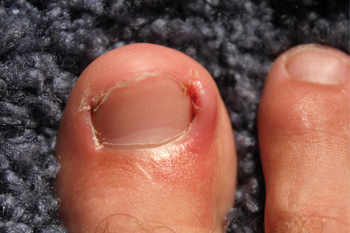 Ingrown toenails occur when the edge of your nail grows into the skin surrounding it instead of growing over the skin as it should. The toenails of the big toe are the most likely to become ingrown. You may notice first milder symptoms of an ingrown toenail. The area surrounding the ingrown nail will often become swollen, tender, and slightly painful to the touch. Without treatment, the ingrown toenail may become infected. Symptoms of an infection can include redness of the surrounding skin, throbbing pain, pus coming out of your toe, and even fever. If you have an ingrown toenail, it is recommended that you visit a podiatrist for treatment. A podiatrist can also give you suggestions on how to prevent ingrown toenails in the future. Some of the preventative measures you can take include cutting your nails straight across and not too short and avoiding uncomfortable shoes that crowd your feet.
Ingrown toenails occur when the edge of your nail grows into the skin surrounding it instead of growing over the skin as it should. The toenails of the big toe are the most likely to become ingrown. You may notice first milder symptoms of an ingrown toenail. The area surrounding the ingrown nail will often become swollen, tender, and slightly painful to the touch. Without treatment, the ingrown toenail may become infected. Symptoms of an infection can include redness of the surrounding skin, throbbing pain, pus coming out of your toe, and even fever. If you have an ingrown toenail, it is recommended that you visit a podiatrist for treatment. A podiatrist can also give you suggestions on how to prevent ingrown toenails in the future. Some of the preventative measures you can take include cutting your nails straight across and not too short and avoiding uncomfortable shoes that crowd your feet.
Ingrown toenails may initially present themselves as a minor discomfort, but they may progress into an infection in the skin without proper treatment. For more information about ingrown toenails, contact one of our podiatrists of Active Foot and Ankle Care, LLC. Our doctors can provide the care you need to keep you pain-free and on your feet.
Ingrown Toenails
Ingrown toenails are caused when the corner or side of a toenail grows into the soft flesh surrounding it. They often result in redness, swelling, pain, and in some cases, infection. This condition typically affects the big toe and may recur if it is not treated properly.
Causes
You are more likely to develop an ingrown toenail if you are obese, have diabetes, arthritis, or have any fungal infection in your nails. Additionally, people who have foot or toe deformities are at a higher risk of developing an ingrown toenail.
Symptoms
Some symptoms of ingrown toenails are redness, swelling, and pain. In rare cases, there may be a yellowish drainage coming from the nail.
Treatment
Ignoring an ingrown toenail can have serious complications. Infections of the nail border can progress to a deeper soft-tissue infection, which can then turn into a bone infection. You should always speak with your podiatrist if you suspect you have an ingrown toenail, especially if you have diabetes or poor circulation.
If you have any questions, please feel free to contact our offices located in Fair Lawn and Riverdale, New Jersey. We offer the newest diagnostic and treatment technologies for all your foot care needs.
Read more about Ingrown Toenails Ingrown toenails occur when the edge of your nail grows into the skin surrounding it instead of growing over the skin as it should. The toenails of the big toe are the most likely to become ingrown. You may notice first milder symptoms of an ingrown toenail. The area surrounding the ingrown nail will often become swollen, tender, and slightly painful to the touch. Without treatment, the ingrown toenail may become infected. Symptoms of an infection can include redness of the surrounding skin, throbbing pain, pus coming out of your toe, and even fever. If you have an ingrown toenail, it is recommended that you visit a podiatrist for treatment. A podiatrist can also give you suggestions on how to prevent ingrown toenails in the future. Some of the preventative measures you can take include cutting your nails straight across and not too short and avoiding uncomfortable shoes that crowd your feet.
Ingrown toenails occur when the edge of your nail grows into the skin surrounding it instead of growing over the skin as it should. The toenails of the big toe are the most likely to become ingrown. You may notice first milder symptoms of an ingrown toenail. The area surrounding the ingrown nail will often become swollen, tender, and slightly painful to the touch. Without treatment, the ingrown toenail may become infected. Symptoms of an infection can include redness of the surrounding skin, throbbing pain, pus coming out of your toe, and even fever. If you have an ingrown toenail, it is recommended that you visit a podiatrist for treatment. A podiatrist can also give you suggestions on how to prevent ingrown toenails in the future. Some of the preventative measures you can take include cutting your nails straight across and not too short and avoiding uncomfortable shoes that crowd your feet.
Ingrown toenails may initially present themselves as a minor discomfort, but they may progress into an infection in the skin without proper treatment. For more information about ingrown toenails, contact one of our podiatrists of Active Foot and Ankle Care, LLC. Our doctors can provide the care you need to keep you pain-free and on your feet.
Ingrown Toenails
Ingrown toenails are caused when the corner or side of a toenail grows into the soft flesh surrounding it. They often result in redness, swelling, pain, and in some cases, infection. This condition typically affects the big toe and may recur if it is not treated properly.
Causes
You are more likely to develop an ingrown toenail if you are obese, have diabetes, arthritis, or have any fungal infection in your nails. Additionally, people who have foot or toe deformities are at a higher risk of developing an ingrown toenail.
Symptoms
Some symptoms of ingrown toenails are redness, swelling, and pain. In rare cases, there may be a yellowish drainage coming from the nail.
Treatment
Ignoring an ingrown toenail can have serious complications. Infections of the nail border can progress to a deeper soft-tissue infection, which can then turn into a bone infection. You should always speak with your podiatrist if you suspect you have an ingrown toenail, especially if you have diabetes or poor circulation.
If you have any questions, please feel free to contact our offices located in Fair Lawn, Riverdale, and Englewood, NJ . We offer the newest diagnostic and treatment technologies for all your foot care needs.
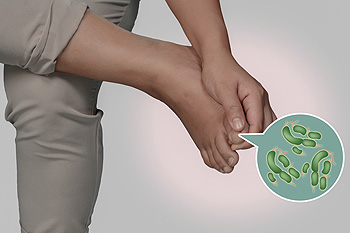 A toenail fungus is not only unsightly, but it may be painful as well. There are many potential risk factors that increase the chances of developing a toenail fungus. Being aware of these risks may help to limit your exposure. If you have a family history of toenail fungus, it is important to monitor your toenails frequently. Other risk factors are shoes, particularly boots, that do not provide proper ventilation, which creates a warm and humid environment for fungi to thrive in. Heavy nail polish prevents light from reaching the toes and increases the risk as well. Additionally, one of the most common places for catching a toenail fungus is a locker room due to the humidity. If you believe that you may have developed a fungal nail infection, it is important to consult with a podiatrist for proper treatment.
A toenail fungus is not only unsightly, but it may be painful as well. There are many potential risk factors that increase the chances of developing a toenail fungus. Being aware of these risks may help to limit your exposure. If you have a family history of toenail fungus, it is important to monitor your toenails frequently. Other risk factors are shoes, particularly boots, that do not provide proper ventilation, which creates a warm and humid environment for fungi to thrive in. Heavy nail polish prevents light from reaching the toes and increases the risk as well. Additionally, one of the most common places for catching a toenail fungus is a locker room due to the humidity. If you believe that you may have developed a fungal nail infection, it is important to consult with a podiatrist for proper treatment.
If left untreated, toenail fungus may spread to other toenails, skin, or even fingernails. If you suspect you have toenail fungus it is important to seek treatment right away. For more information about treatment, contact one of our podiatrists of Active Foot and Ankle Care, LLC. Our doctors can provide the care you need to keep you pain-free and on your feet.
Symptoms
Treatment
If self-care strategies and over-the-counter medications does not help your fungus, your podiatrist may give you a prescription drug instead. Even if you find relief from your toenail fungus symptoms, you may experience a repeat infection in the future.
Prevention
In order to prevent getting toenail fungus in the future, you should always make sure to wash your feet with soap and water. After washing, it is important to dry your feet thoroughly especially in between the toes. When trimming your toenails, be sure to trim straight across instead of in a rounded shape. It is crucial not to cover up discolored nails with nail polish because that will prevent your nail from being able to “breathe”.
In some cases, surgical procedure may be needed to remove the toenail fungus. Consult with your podiatrist about the best treatment options for your case of toenail fungus.
If you have any questions, please feel free to contact our offices located in Fair Lawn, Riverdale, and Englewood, NJ . We offer the newest diagnostic and treatment technologies for all your foot care needs.
 A toenail fungus is not only unsightly, but it may be painful as well. There are many potential risk factors that increase the chances of developing a toenail fungus. Being aware of these risks may help to limit your exposure. If you have a family history of toenail fungus, it is important to monitor your toenails frequently. Other risk factors are shoes, particularly boots, that do not provide proper ventilation, which creates a warm and humid environment for fungi to thrive in. Heavy nail polish prevents light from reaching the toes and increases the risk as well. Additionally, one of the most common places for catching a toenail fungus is a locker room due to the humidity. If you believe that you may have developed a fungal nail infection, it is important to consult with a podiatrist for proper treatment.
A toenail fungus is not only unsightly, but it may be painful as well. There are many potential risk factors that increase the chances of developing a toenail fungus. Being aware of these risks may help to limit your exposure. If you have a family history of toenail fungus, it is important to monitor your toenails frequently. Other risk factors are shoes, particularly boots, that do not provide proper ventilation, which creates a warm and humid environment for fungi to thrive in. Heavy nail polish prevents light from reaching the toes and increases the risk as well. Additionally, one of the most common places for catching a toenail fungus is a locker room due to the humidity. If you believe that you may have developed a fungal nail infection, it is important to consult with a podiatrist for proper treatment.
If left untreated, toenail fungus may spread to other toenails, skin, or even fingernails. If you suspect you have toenail fungus it is important to seek treatment right away. For more information about treatment, contact one of our podiatrists of Active Foot and Ankle Care, LLC. Our doctors can provide the care you need to keep you pain-free and on your feet.
Symptoms
Treatment
If self-care strategies and over-the-counter medications does not help your fungus, your podiatrist may give you a prescription drug instead. Even if you find relief from your toenail fungus symptoms, you may experience a repeat infection in the future.
Prevention
In order to prevent getting toenail fungus in the future, you should always make sure to wash your feet with soap and water. After washing, it is important to dry your feet thoroughly especially in between the toes. When trimming your toenails, be sure to trim straight across instead of in a rounded shape. It is crucial not to cover up discolored nails with nail polish because that will prevent your nail from being able to “breathe”.
In some cases, surgical procedure may be needed to remove the toenail fungus. Consult with your podiatrist about the best treatment options for your case of toenail fungus.
If you have any questions, please feel free to contact our offices located in Fair Lawn and Riverdale, New Jersey. We offer the newest diagnostic and treatment technologies for all your foot care needs.
Read more about Treating Toenail Fungus
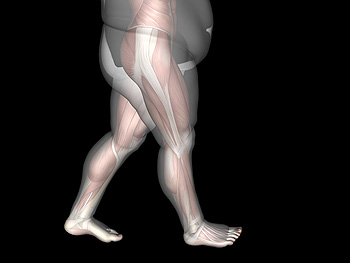 Obesity is an increasingly prevalent problem worldwide that can lead to a variety of health complications. One such complication is increased foot and ankle pain. A recent study of individuals with severe obesity found that 68.7% suffer from foot and ankle pain. Swelling of the lower limbs, degree of obesity, and percentage of total body fat were strongly associated with pain in the feet and ankles. Researchers found that the greater the individual’s body mass, the more force was exerted on the lower limbs, leading to an increased risk of lower limb injuries and pain. If you are experiencing foot and ankle pain, it is recommended that you consult with a podiatrist.
Obesity is an increasingly prevalent problem worldwide that can lead to a variety of health complications. One such complication is increased foot and ankle pain. A recent study of individuals with severe obesity found that 68.7% suffer from foot and ankle pain. Swelling of the lower limbs, degree of obesity, and percentage of total body fat were strongly associated with pain in the feet and ankles. Researchers found that the greater the individual’s body mass, the more force was exerted on the lower limbs, leading to an increased risk of lower limb injuries and pain. If you are experiencing foot and ankle pain, it is recommended that you consult with a podiatrist.
Obesity has become very problematic at this point in time and can have extremely negative effects on the feet. If you’re an obese individual and are concerned about your feet, contact one of our podiatrists from Active Foot and Ankle Care, LLC. Our doctors can provide the care you need to keep you pain-free and on your feet.
Obesity and Your Feet
Since your feet are what support your entire weight when standing, any additional weight can result in pain and swelling. Being overweight is one of the main contributors to foot complications.
Problems & Complications
Extra Weight – Even putting on just a few extra pounds could create serious complications for your feet. As your weight increases, your balance and body will shift, creating new stresses on your feet. This uneven weight distribution can cause pain, even while doing the simplest tasks, such as walking.
Diabetes – People who are overweight are at serious risk of developing type-2 diabetes, which has a drastic impact on the health of your feet. As you get older, your diabetes might worsen, which could lead to loss of feeling in your feet, sores, and bruises. You could also become more prone to various infections.
Plantar fasciitis – Pressure and stress that is placed on muscles, joints, and tendons can trigger plantar fasciitis, which is an inflammation of tissue that forms along the bottom of the foot.
If you have any questions please feel free to contact our offices located in Fair Lawn and Riverdale, New Jersey. We offer the newest diagnostic and treatment technologies for all your foot and ankle needs.
Read more about How Obesity Affects Your Feet Obesity is an increasingly prevalent problem worldwide that can lead to a variety of health complications. One such complication is increased foot and ankle pain. A recent study of individuals with severe obesity found that 68.7% suffer from foot and ankle pain. Swelling of the lower limbs, degree of obesity, and percentage of total body fat were strongly associated with pain in the feet and ankles. Researchers found that the greater the individual’s body mass, the more force was exerted on the lower limbs, leading to an increased risk of lower limb injuries and pain. If you are experiencing foot and ankle pain, it is recommended that you consult with a podiatrist.
Obesity is an increasingly prevalent problem worldwide that can lead to a variety of health complications. One such complication is increased foot and ankle pain. A recent study of individuals with severe obesity found that 68.7% suffer from foot and ankle pain. Swelling of the lower limbs, degree of obesity, and percentage of total body fat were strongly associated with pain in the feet and ankles. Researchers found that the greater the individual’s body mass, the more force was exerted on the lower limbs, leading to an increased risk of lower limb injuries and pain. If you are experiencing foot and ankle pain, it is recommended that you consult with a podiatrist.
Obesity has become very problematic at this point in time and can have extremely negative effects on the feet. If you’re an obese individual and are concerned about your feet, contact one of our podiatrists from Active Foot and Ankle Care, LLC. Our doctors can provide the care you need to keep you pain-free and on your feet.
Obesity and Your Feet
Since your feet are what support your entire weight when standing, any additional weight can result in pain and swelling. Being overweight is one of the main contributors to foot complications.
Problems & Complications
Extra Weight – Even putting on just a few extra pounds could create serious complications for your feet. As your weight increases, your balance and body will shift, creating new stresses on your feet. This uneven weight distribution can cause pain, even while doing the simplest tasks, such as walking.
Diabetes – People who are overweight are at serious risk of developing type-2 diabetes, which has a drastic impact on the health of your feet. As you get older, your diabetes might worsen, which could lead to loss of feeling in your feet, sores, and bruises. You could also become more prone to various infections.
Plantar fasciitis – Pressure and stress that is placed on muscles, joints, and tendons can trigger plantar fasciitis, which is an inflammation of tissue that forms along the bottom of the foot.
If you have any questions please feel free to contact our offices located in Fair Lawn, Riverdale, and Englewood, NJ . We offer the newest diagnostic and treatment technologies for all your foot and ankle needs.
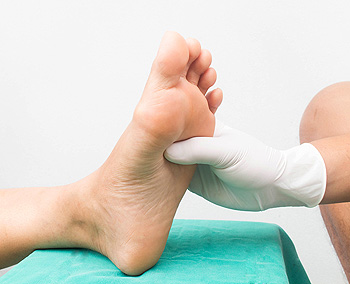 Vascular testing is used by podiatrists to make sure that there is adequate blood flow to your lower limbs. Reduced blood flow can be dangerous if left undiagnosed and untreated. Vascular testing may be performed if you are experiencing pain, numbness, or weakness in your legs, have poorly healing wounds, or have a history of diabetes or cardiovascular disease. Vascular tests are generally noninvasive and painless. The doctor may perform an ultrasound of your legs and feet, check your pulse by hand, measure and compare the blood pressures of your arm and ankle, and perform a visual examination of your lower limbs. If you suspect that you may have reduced blood flow to your legs, discuss it with your podiatrist today.
Vascular testing is used by podiatrists to make sure that there is adequate blood flow to your lower limbs. Reduced blood flow can be dangerous if left undiagnosed and untreated. Vascular testing may be performed if you are experiencing pain, numbness, or weakness in your legs, have poorly healing wounds, or have a history of diabetes or cardiovascular disease. Vascular tests are generally noninvasive and painless. The doctor may perform an ultrasound of your legs and feet, check your pulse by hand, measure and compare the blood pressures of your arm and ankle, and perform a visual examination of your lower limbs. If you suspect that you may have reduced blood flow to your legs, discuss it with your podiatrist today.
Vascular testing plays an important part in diagnosing disease like peripheral artery disease. If you have symptoms of peripheral artery disease, or diabetes, consult with one of our podiatrists from Active Foot and Ankle Care, LLC. Our doctors will assess your condition and provide you with quality foot and ankle treatment.
What Is Vascular Testing?
Vascular testing checks for how well blood circulation is in the veins and arteries. This is most often done to determine and treat a patient for peripheral artery disease (PAD), stroke, and aneurysms. Podiatrists utilize vascular testing when a patient has symptoms of PAD or if they believe they might. If a patient has diabetes, a podiatrist may determine a vascular test to be prudent to check for poor blood circulation.
How Is it Conducted?
Most forms of vascular testing are non-invasive. Podiatrists will first conduct a visual inspection for any wounds, discoloration, and any abnormal signs prior to a vascular test.
The most common tests include:
These tests are safe, painless, and easy to do. Once finished, the podiatrist can then provide a diagnosis and the best course for treatment.
If you have any questions, please feel free to contact our offices located in Fair Lawn and Riverdale, New Jersey. We offer the newest diagnostic and treatment technologies for all your foot care needs.
Read more about Vascular Testing in Podiatry






